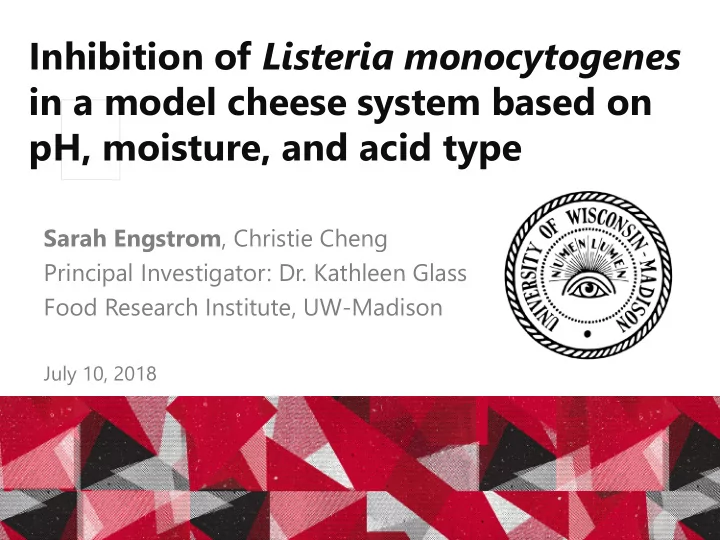

Inhibition of Listeria monocytogenes in a model cheese system based on pH, moisture, and acid type Sarah Engstrom , Christie Cheng Principal Investigator: Dr. Kathleen Glass Food Research Institute, UW-Madison July 10, 2018 March 3, 2016
Soft, unaged cheeses L. monocytogenes • Made via acid and/or rennet • Ubiquitous organism with 20% addition ( no starter ) fatality • Standard of Identity not • Psychrotrophic (-0.4 ° C / 31.1 ° F established for some varieties min) • Refrigeration is typically only • Main concern = post- post-manufacturing hurdle processing contamination • 287 million lbs Latin-style • $60M to $2B annual cost due cheese produced in 2017 ( 316% to illness from dairy foods increase from 1997) ILSI 2005; Batz 2011; USDA-ERS 2016.
Forever Oasis La Nica Cheese Brands Products Ricotta 6 Latin- 2 Latin- Salata style style 2012 2018 Roos Karoun Dairies Panera Foods Queso Cream 16 Latin- fresco/blanco, cheese style feta, mozzarella CDC 2012-2018.
Objective To determine the effect of pH, moisture, and acid type on the growth of L. monocytogenes in a model cheese system Acid pH Moisture 4 acid types Citric 5.25 50% Lactic 5.50 56% 4 pH values 32 cheeses Acetic 5.75 2 moistures Propionic 6.00 Salt constant (1.25%)
Methods – Model System • Model soft cheese system: -Cream (pasteurized, 40% fat) -Micellar casein -Sterile water -Lactose -Salt • pH adjustment using organic acids (citric, lactic, acetic, or propionic)
Methods – Inoculation • Inoculated with 3-log CFU/g (0.5% v/w) 5-strain L. monocytogenes cocktail: LM 108 - hard salami LM 301 - cheddar LM 310 - goat’s milk cheese R2-500 - food outbreak R2-501 - clinical isolate • Mixed 2 minutes to distribute • 25 g portions vacuum-sealed • Each formulation replicated in duplicate trials
Methods – L. monocytogenes Enumeration Samples stored at 4 ° C and plated at time 0 and weekly through 8 weeks + Serial dilutions in Triplicate samples 1:2 dilution in 0.1% 30 sec 0.1% peptone peptone Modified Oxford agar 2 days 35 ° C
Methods – Uninoculated Sample Enumeration Samples stored at 4 ° C and plated at time 0, 4, and 8 weeks + Serial dilutions in Duplicate samples 1:2 dilution in 0.1% 30 sec 0.1% peptone peptone pH measured weekly Plate Count agar MRS agar Potato dextrose agar 2 days 35 ° C 2 days 35 ° C 5 days 21 ° C
Methods – Proximate Analysis Uninoculated 0-time samples of each treatment were analyzed to confirm target parameters pH Moisture Salt a w
10 10 Citric Acid Lactic Acid 9 9 8 8 7 7 log CFU/g log CFU/g 6 6 5 5 4 4 3 3 2 2 0 1 2 3 4 5 6 7 8 9 0 1 2 3 4 5 6 7 8 9 Weeks at 4 ° C Weeks at 4 ° C 10 10 Propionic Acid Acetic Acid 9 9 8 8 7 7 log CFU/g log CFU/g 6 6 5 5 4 4 3 3 2 2 0 1 2 3 4 5 6 7 8 9 0 1 2 3 4 5 6 7 8 9 Weeks at 4 ° C Weeks at 4 ° C
Data Handling – DMFit 64 curves fitted for Lag and Growth Rate
Full Model • Independent variables: acid type, target pH, target moisture, target pH*target moisture interaction, trial • Dependent variables: Lag, Growth Rate Reduced Model • Independent variables: acid type , target pH • Dependent variables: Lag , Growth Rate Tukey’s HSD Lag Phase Growth Rate (log (weeks) CFU/g per week) Citric A Citric A Lactic B Lactic A Acetic C Acetic B Propionic C Propionic B
Example - cheese pH 5.6 1-log L. monocytogenes growth at: • 1 week – citric • 3.5 weeks – lactic • >8 weeks – acetic or propionic Citric Lactic Acetic Propionic 8 7 6 log CFU/g 5 4 3 2 0 1 2 3 4 5 6 7 8 Weeks at 4°C
Conclusions • L. monocytogenes growth is dictated by acid type and pH in model cheeses of 50-56% moisture • Efficacy of organic acids follows pK a value • Citric 3.13, Lactic 3.83, Acetic 4.75, Propionic 4.88 • Acetic and propionic model cheeses performed similarly • Our model cheese system can be used to screen antilisterial ingredients
Acknowledgements • Funding: National Dairy Council • Technical: Randy Brandsma (Schreiber); Gina Mode, Mike Molitor, John Lucey (CDR) • Modeling: Dennis Seman (Meat Science) • Lab: Makala Bach, Morgan Brown, Christie Cheng, Max Golden, Quinn Huibregtse, Jie Yin Lim, Kori Scherer, Sam Trotter, Megan Wagner, and Brandon Wanless
THANK YOU 16
Phase I Results Cheese Acid % Total Acid (mM) Undissociated pH Undissociated Acid (mM) 5.25 Citric 0.7 29.93 0.21 TEST Lactic 4.7 140.40 6.87 Acetic 25.0 99.09 24.76 Propionic 27.2 117.70 32.00 Acid pKa 5.50 Citric 0.4 18.52 0.08 Citric 3.13 Lactic 2.4 72.14 1.73 Acetic 15.8 60.61 9.57 Lactic 3.83 Propionic 19.5 80.65 15.69 Acetic 4.75 5.75 Citric 0.3 10.23 0.03 Lactic 1.3 41.99 0.56 Propionic 4.88 Acetic 10.6 38.38 4.08 Propionic 11.7 40.11 4.68 6.00 Citric 0.1 3.67 0.01 Lactic 0.7 14.08 0.10 Acetic 5.6 12.41 0.70 Propionic 6.8 14.82 1.00
Antimicrobial Activity of Organic Acids TEST Higher pKa, higher antimicrobial activity Mani-Lopez 2012.
Antimicrobial Activity of Organic Acids Extracellular TEST pH = 5.25 Citric Acetic pKa’s: 3.13 , 4.76, 6.40 pKa: 4.76 0.7% 25.0% Propionic Lactic pKa: 4.87 pKa: 3.86 27.2% 4.7%
Recommend
More recommend